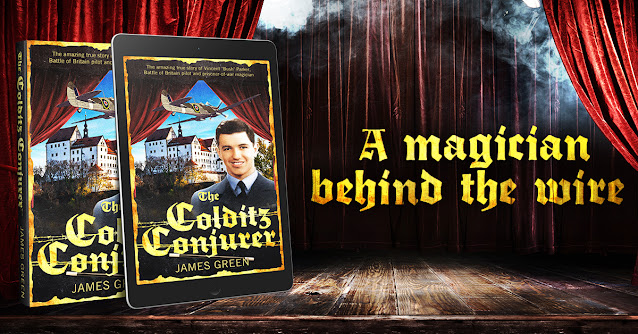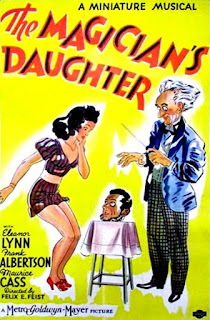Miss Blanche: 'The Lady Magician' uses magic to survive Nazi experiments
This is the amazing survival story of Miss Blanche (aka Ruth Iris Wachsmann) who was one of the leading female magicians in pre-war Europe. An expert manipulator, she headlined in venues across the continent, until war intervened...
Ruth Iris Wachsmann was a German Jew. Born in Berlin on 1 September 1910, she first trained as a ballerina. In her mid-teens, after seeing a performance by Austro-Hungarian magician Larette (Cornelius Hauer), she switched from dancing to magic. Wachsmann became Larette's student, and she learned the art of manipulation. She could manipulate billiard balls and playing cards, but showed special aptitude for cigarette manipulation.

Miss Blanche, performing cigarette manipulation, 1936
(Source: Artefake)
Inspired by a brand of cigarettes designed to appeal to female smokers by the Rotterdam-based Vittoria Egyptian Cigarette Company, she adopted the stage name Miss Blanche. Larette was sponsored by Miss Blanche cigarettes and helped promote Wachsmann as another act to market the brand.
Promotion card for Amsterdam-based Larette, with an advert for Miss Blanche cigarettes on the reverse
(Source: Quicker Than the Eye, Potter & Potter Auctions)
Adopting an androgynous look - short, boyish hair and a tailcoat costume - Wachsmann's act included manipulation, the Chinese rings, tricks with cards and ropes, producing glasses of beer from an empty barrel, and a final production of Japanese banners and paper flowers.
Miss Blanche's beer from an empty barrel prop
(Source: German Magic Foundation, by kind permission)
Often billed as 'The Lady Magician' or 'The Only Beautiful Lady Magician', she was one of few female magicians able to produce and vanish lit cigarettes. "Combined with her charming personality, and her unique sweet way of presentation, every performance of hers is a delightful sight worth seeing," said Austrian magician Ottokar Fischer.
Miss Blanche (Ruth Iris Wachsmann)
(Source: Artefake)
With Larette as her excellent mentor and teacher, Wachsmann emerged as a successful magician. Able to present her act in Dutch, English, French, German and Italian, she toured throughout Europe. Eventually, becoming a headliner, she came to be regarded as the 'Premier Lady Magician' on the continent. She played top venues like the 'Pik-Bar' in Zagreb, Schiefe Laterne Kabarett in Vienna, and the Moulin Rouge in Budapest. While touring Yugoslavia, Wachsmann was called on to perform for Peter II on his fifteenth birthday. And she was accepted into the Magischer Zirkel von Deutschland (The Magic Circle of Germany).

Promotional advert for Miss Blanche
(Source: Artefake)
After the Nazis took power in Germany in 1933, life became increasingly difficult for the half a million Jews living there. The persecution of Jews became an official Nazi policy. In 1935 and 1936, the pace of anti-Semitic persecution sped up. About 60% of Jews emigrated, many after they were banned from holding professional jobs. Wachsmann was kicked out of the Magischer Zirkel and in 1939 fled from Germany.
She settled in the Netherlands and got onto the entertainment circuit there. A review of one of her performances at the Kurhaus Caberet in Scheveningen, a suburb of The Hague, appeared in The Magic Wand periodical in October that year:
"Attired in male evening dress, this lady magician opened with lighted cigarette manipulation, the item being presented with elegant moves and good misdirection. The Chinese Rings followed and then the production of beer from a barrel. This last had an amusing termination for, finally, two huge glasses were filled with the beverage and a spectator was invited to enter into a drinking competition with the performer. Miss Blanche won easily. An amusing little turn, very well received."
On 24 January 1940, Ruth married a German-Jewish man who'd also relocated to the Netherlands to escape NAzi persecution. Her husband, Marcus Wolf Teitz, was an elocutionist and performed comic voices under the stage name Max Peltini. Together, they were able to make living travelling to venues within the Low Countries and France, and even had plans to move to the U.S.A.
But, in May 1940, Nazi Germany invaded and occupied the Netherlands and the couple's situation worsened. Bookings for all performers, magicians or not, Jewish or not, were becoming few and far between as the war progressed. Once over-crowded, night clubs and theatres were emptying. Now the patrons frequenting the clubs were German soldiers, and many Dutch performers did not want to entertain the enemy. Restrictions on Jewish performers would have denied Wachsmann the scraps of bookings that were still available. Now under the name Ruth Wolf, she dyed her hair blond to look less Jewish.
As their occupation progressed, the Nazis imposed arduous rules on Jews and concentrated them in ghettos. Earning a living as a magician became extremely difficult and she eventually found other work, as a social worker, probably working for the Dutch Jewish Council.
Tragically, Wachsmann's husband, Marcus Teitz, was arrested and killed by the Nazis in April 1942.
After his death, she remained in the ghetto under at least late January 1943. At that point, or possibly some months later, 33-year-old Wachsmann was ordered by the German-controlled authorities to report for deportation.
She was moved first to the Westerbork transit camp in the country's northeast. Westerbork was a staging camp from where the Germans deported Jews and other Untermenschen (sub-humans: Nazi term) to camps in concentration and extermination camps in Germany or Poland. Camp Westerbork had a school, orchestra, hairdresser and other facilities, designed by S.S. officials to give inmates a false sense of hope for survival and to aid in avoiding problems during their onward transportation. Wachsmann may have been there for several months or, like most, just a few days. From Westerbork, on 14 September 1943, she was sent by train to Auschwitz in Poland.
As the war developed, the Nazis constructed three main camps at Auschwitz, along with many sub-camps. Auschwitz I was originally built for Polish prisoners-of-war and later used as a concentration camp. Auschwitz II-Birkenau was primarily an extermination camp. Auschwitz III was mainly a slave labour camp.
Wachsmann was allocated to Auschwitz I. She has put into an accommodation block (Block 10) reserved for women on which medical experiments were carried out. S.S. physicians working at the camp included gynecologist Professor Dr. Carl Clauberg, who developed a method of non-surgical sterilisation. From April 1943 to May 1944, he treated several hundred female prisoners, mostly Jewish, with chemical irritants. Some of them died during the experiments, while others were put to death so their bodies could be autopsied to examine the effectiveness of the chemicals. Those who survived were left with permanent injuries.
In these terrible conditions, her captors identified Wachsmann's magic skills. They forced her to perform magic for S.S. physicians and visiting German dignitaries. While she took no pleasure in entertaining the Germans, magic earned her scraps of food and protection from execution.
In some small way, Wachsmann's experience in World War Two mirrored that of her mentor, Larette. During World War One, as a conscript in the Austro-Hungarian army, the Russians captured him. While a prisoner, he performed magic to boost the morale of his fellow captives and entertain guards to earn food and privileges.
Female prisoners at Auschwitz concentration camp
(Source: Creative Commons)
Auschwitz-Birkenau was the largest of the German Nazi concentration camps and extermination centres. Over 1.1 million men, women and children lost their lives there.
Wachsmann endured imprisonment for almost two years. Eventually, in January 1945, when she was on the brink of death, the camp was liberated by Soviet troops. Severely malnourished, Wachsmann weighed just 65 lbs (29 kgs) and was on the verge of death when she was freed. But she had survived, thanks to her magical talent.
She returned to the Netherlands and started to rebuild her life. In 1949, Wachsmann remarried and became Mrs Ruth Neumann. With her new husband, she emigrated to the United States in 1956, and magic gradually disappeared from her life.
Ruth Neumann (nee Wachsmann), skilled lady magician and Holocaust survivor, died in April 1989, aged 78.
Miss Blanche poster (1930s?)
(Source: Archive of Ritsko van Vliet. Notes by Van Vliet about Miss Blanche. Box 26, cover Miss Blanche. Allard Pierson Theater Collection)
Larette (Cornelius Hauer) was also a Jew. Unlike his student, Larette did not survive Nazi Germany's anti-Semitic persecutions. On 14 May 1943, fearing he was about to be arrested by the Gestapo secret police, Larette shot himself. The German magic magazine, Magie, reported that he died "after an Allied bombing raid on Amsterdam".
Related article: 'Dutch magician deported to extermination camp', tells the wartime story of card magician Louis Lam. Blog link.
Related article: 'Hungarian magician, Dr. Laszlo Rothbart survives Nazi concentration camp'. Blog link.
Research supported by The Good Magic Award 2021 from The Good Thinking Society

*** AVAILABLE NOW ***
The Colditz Conjurer tells the amazing true story of Flight Lieutenant Vincent ‘Bush’ Parker, Battle of Britain pilot and prisoner-of-war magician.
Written by the Magic at War team, The Colditz Conjurer is a remarkable tale of perseverance, courage and cunning in the face of adversity. It features over 55 original photographs and maps. 126 pages.















London zoom magic Pretty good post. I just stumbled upon your blog and wanted to say that I have really enjoyed reading your blog posts. Any way I'll be subscribing to your feed and I hope you post again soon. Big thanks for the useful info.
ReplyDeleteMany thanks for reading the blog and sending a comment. There's lots more stories to come. 'Escape and POW' stories are my theme for the year.
ReplyDeleteI found your blog on Google and read a few of your other posts. I just added you to my Google News Reader. You can also visit world class magician for more Forzoni Magic related information and knowledge, Keep up the great work Look forward to reading more from you in the future.
ReplyDelete